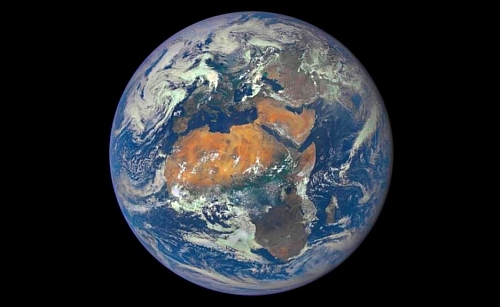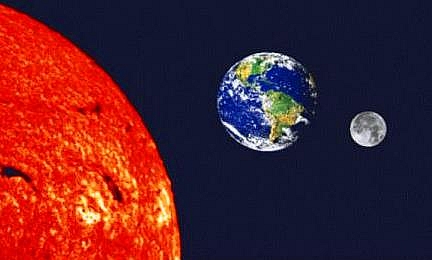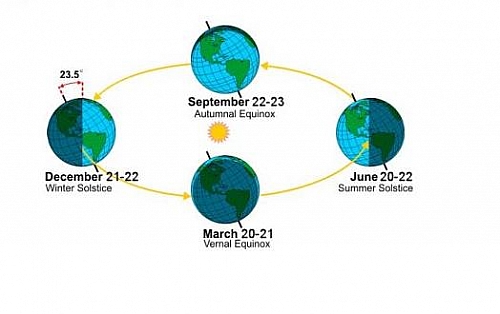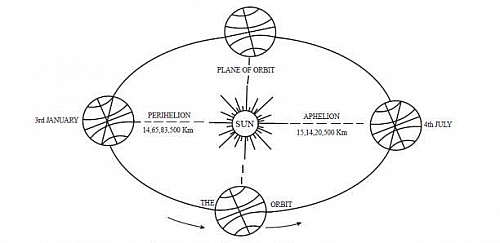Table of Contents
Earth is the third planet in order from the sun and the fifth largest planets in the solar system. This is the only plane of all other planets that supports life, as there are millions of species of life ranging from very little to very large. In this article, you are going to learn the most interesting facts about the Earth planet, its moons, seasons, rotation, orbit, atmosphere and surface including the physical characteristics of Earth planet. You are also going to know the different names we call Earth.
Interesting Facts About the Earth
- Spacemen have often described the Earth as a beautiful jewel when seen from space.
- Earth is the only planet that supports the existence, man, plants and animals.
- Earth is the fifth largest terrestrial planet and it is the densest in the solar system.
- Earth takes about 365 days to complete its orbit. The distance between the sun and the Earth is about 148800km.
- It takes Earth 23.439 hours to complete a rotation on its axis
- Earth has a natural satellite called the Moon which revolves eastwards around the earth once in every 27 days, rings and the moon is our nearest neighbour
- The distance of the earth from the moon is 384,629km
- The diameter of the Earth at the equator is 43 kilometers (27mi) larger than thepole-to-pole diameter.
- Earth orbits the Sun at an average distance of about 150, 800,000km every 365.2564 mean solar days, or onesidereal year. 92,956,050 miles (149,598,262 km)
- The diameter of the Earth is roughly12,760 km (7,926 miles).
- Earths atmosphere is made up of 78% nitrogen, 21% oxygen and 1% of other gases which makes it a perfect place for living things to live.s
What is Earth?
Earth is the third planet from the sun; it is the home of living things including man, animals and plants since it has the right kind of atmosphere and water for living things. Earth is very large, it is the fifth largest and densest of all the planets in our solar system, however, it is smaller than Jupiter,Saturn,Uranus andNeptune (the four gas giants) but larger than Mercury,Mars andVenus (the rocky planets). Earth planet does not get as hot as Venus planet,the highest temperature ever recorded on Earth is about 1350F (600C) while the lowest recorded temperature is about -1250F (-850C). Earth has an average distance of 150, 800,000km from the sun. Its diameter is about 12,760 km (7,926 miles). Earth takes 23 hours 56 minutes and 4 seconds to rotate on its own axis. The earth planet takes 365 days 5 hours 48 minutes 47 seconds to revolve round the sun once a year; therefore, one year is equivalent to 365 days. The moon is the single natural satellite of the earth, which revolves round the earth once in every 27days; however, the distance of the Earth from the moon, is 384,629km. The earth is the only planet in whose atmosphere there is existence of required oxygen, nitrogen, carbon dioxide and temperature that is necessary for the survival of humans, plants and animals. Hence, planet earth is considered as the most important planet in the solar system that hosts life. There are several million known species of life, ranging from the bottom of the deepest ocean to a few miles into the atmosphere, their sizes range from very tiny to very large. Scientists think that are still very many that yet to be discovered. Earth was first studied by American astronauts in 1968; they were the first to travel by spacecraft to the moon to take picture of the whole Earth.
Another name for Earth
Earth is known as the only planet whose English name does not derive from Greek or Roman mythology. The name is derived from Old English and Germanic. There are of course, hundreds of other names for Earth in Roman Mythology, the goddess of the Earth wasTellus.
Earth is usually refers to the beautiful jewel Other names for Earth include the Big Blue Marble, third rock from the Sun, and the blue pebble in the cosmic ocean, mother Earth, the fertile soil, Gaia,terra materand the Globe, etc.
Earth’s Moon
Earth has only one moon with no rings, the moon is our nearest neighbour in the solar system; it follows a path or orbit around the Earth, while the Earth follows a path around the sun. The Earths moon has mountains and valleys; the surface of the moon is rocky and covered with dust crater. The moon atmosphere is thinner than Mercurys atmosphere, the temperature on the moon can reach up to 2650F (13300C). Since there is almost no atmosphere in the moon, the temperature can drop to -1700F (-1100C) at night. There is no water on the moon and life doesnt exist there either because there is no water nor air in the moon. Between 1969 and 1972, twelve American astronauts walked on the moon and took picture of of Luna rocks and dirt to have more insight of the moon. From their discovery, they found out that the surface of the moon seems colder than the surface of the Earth.
The Surface of the Earth
The surface of the Earth is similar to the surface of Mercury and Venus, Earth is hard and rocky, there are high mountains, valleys, volcanoes and even some crater on planet Earth. Earth is different in some very important ways. Most of the planet is covered with water and 71% of its surface is covered with water, the air is made of nitrogen, oxygen and carbon dioxide. There is evidence of clouds on earth , the clouds in the air brings rain and snow on land, water provides drinks for man and animals and also helps to wet the soil for plant growth. Volcanoes are also seen on land; they help release gas and dust into the air. Below the surface of the Earth are layers of rock, minerals and metal, these are all useful to man and they have a unique way of beautifying the earth.
However, the totalsurface areaof Earth is about 510millionkm2(197millionsqmi) out of this, 70.8%, or 361.13millionkm2(139.43millionsqmi), is below sea level and covered by ocean water. Continental shelf, mountains, volcanoes,oceanic trenches,submarine canyons,oceanic plateaus, abyssal plains, and a globe-spanning mid-ocean ridge system are also found below the ocean surface. The remaining 29.2% or 148.94millionkm2(57.51millionsqmi) that is not covered by water hasterrainthat varies greatly from place to place and consists of mountains, deserts, plains, plateaus, and otherlandforms.Tectonics erosion, volcanic eruptions,flooding,weathering,glaciation, the growth ofcoral reefs, andmeteorite impactsare among the processes that constantly reshape the Earth’s surface overa long period of time.
Earths Atmosphere
The atmosphere where we live is very unique in different ways, it protects us from incoming meteoroids, most of which break up in our atmosphere before they can strike the surface, the atmosphere is made up of 78% nitrogen, 21% oxygen and 1% of other gases which makes it a perfect place for living things to live.
Seasons on Earth
24 hours make up a day on Earth and a whole day is divided into two, we have the day, which is the light, and night in which we experience darkness; the sun lights half of the earth and half of it is without the sun. It takes 365 day for Earth to make a complete orbit around the sun (a year in Earth time). Some of the areas that face the sun experience daytime, while the areas that look away from the sun experience night time or darkness. Due to the continuous spinning of the planet, most places on Earth cycle through day and night once every 24 hours. The North Pole and South Pole have constant daylight or darkness depending on the time of year.
Similarly, Earth has seasons as a result of its tilting axis; the whole year is being divided into 4 divisions based on the variation of temperature. Each of the divisions is known as a season. These are the summer, autumn, winter and spring you often hear about. The rays of the sun hit different parts of the planet more directly depending on the time of year. However, from June to August, the sun’s rays hit the Northern Hemisphere more directly than the Southern Hemisphere. The outcome is warm (summer) weather in the Northern Hemisphere and cold (winter) weather in the Southern Hemisphere. From December to February, the sun’s rays shines on the Northern Hemispherelessdirectly than the Southern Hemisphere. The outcome is cold (winter) weather in the Northern Hemisphere and warm (summer) weather in the Southern Hemisphere. From September to November, the sun shines equally on both hemispheres. The result is fall in the Northern Hemisphere and spring in the Southern Hemisphere. The sun also shines equally on both hemispheres from March to May. The result is spring in the Northern Hemisphere and fall in the Southern Hemisphere.
Earth rotation
The earth is constantly in motion, the earth moves from west to east on its axis. This motion of the earth is known as Earth rotation. Earth takes about 23 hours 56 minutes and 4 seconds or nearly 24 hours to rotate once on its axis. This period of 24 hours is known as one day on Earth. One such full rotation of the earth is known as solar day. The earth takes a full day to complete rotation once on her axis. The speed of rotation is different in different places. The speed of rotation at the equator is highest. Here the speed of rotation is more than 1,610 kilometers per hour. This speed decreases towards north and south of the equator. The speed of the rotation is nearly zero at the poles. Though the diurnal motion exists, but still we dont feel this because-
- We are very much insignificant when compared to the size of the earth, so we do not feel the speed. There is no fixed or movable object available in front of the earth in the space which can be taken as the basis to understand the rotational speed of the earth.
- Keeping pace with the speed of the earth, the atmosphere also moves from west to east, that is why, we cant feel the rotational speed of the earth.
- The rotational speed of each of the places of the earth is fixed.
The rotation of the earth bring about day and night, one of the effects of the earths rotation is the occurrence of day and night. We know that the Earth does not have any light of its own. The light of the sun illuminates the earth. Due to diurnal motion, that part of the earth, which faces the sun, becomes illuminated. It is day in the illuminated portion of the earth. Sunlight does not reach out to the opposite part of the illuminated portion. Therefore, it remains dark and it is night in the dark portion of the earth. Due to rotation of the earth, similarly, the illuminated portion becomes dark, the dark portion becomes illuminated, and that is why the day and night are changed. When the dark portion is illuminated, it becomes day there. Similarly, the illuminated portion turns dark, it becomes night there. Thus, day and night have been occurring alternately. Therefore, in some places it is 12 hours of day and 12 hours of night. If the shape of the earth would have been flat instead of being round, the rotation of the earth would create only day or only night. In other words, either only day or only night would exist simultaneously over the globe. On a specific date, in some parts of the earth it is day whereas in other parts it is night. That means when a portion of the earth remains dark the other part becomes illuminated. The border of the lighted and the dark portion is called the shadow circle. Due to rotation, when the dark portion, after crossing the shadow circle faces the light, it is known as morning. The feeble light which precedes the morning is known as dawn and similarly the feeble light that precedes the evening is called twilight. In any place, when the sun reaches the highest elevation of the sky it is known as midday or noon and the time recorded is 12 O clock, however, in the opposite point of that place it is midnight.
Perihelion and Aphelion
Earth’s orbit is not a perfect circle, but is rather an oval-shaped ellipse, like that of the orbits of all the other planets in the solar system. Earth is a bit closer to the sun in early January and farther away in July, although this variation has a much smaller effect than the heating and cooling caused by the tilt of Earth’s axis. Earth happens to lie within the so-called “Goldilocks zone” around its star, where temperatures are just right to maintain liquid water on its surface. The orbit of the earth is an ellipse. Its length is 93, 80, 51,827 kilometers. The sun is located in the centre or in the focus of the ellipse.
Perihelion: In the process of revolution around the sun, the earth on 1st to 3rd January reaches in such a position that the distance between the sun and the earth becomes closer. It is about 14 crore 65 lakh 83000, 500km. This position of the earth on that date is known as Perihelion. In Perihelion position, the axis of the earth lie aslant outside the orbit.
Aphelion : As the orbit of the earth is ellipse, the distance between the sun and the earth does not remain fixed for all the time of the year. Sometimes the distance increases and other times it decreases. In the first half of July, particularly on 4th July, the distance between the sun and the earth becomes the highest being 15 crore 14 lakh 20,000,500 kilometres. This position of the earth is known as Aphelion.
Nearest planet to Earth
The nearest planet to Earth varies, depending on where they are in their respective orbits. Venus is the second planet in the solar system and closest to Earth planet, When Venus lies between Earth and the Sun, it experiences what is known as an inferior conjunction. It is at this point that it makes its closest approach to Earth (and that of any planet) with an average distance of 41 million kilometers (25,476,219 mi). However, there are also times that Mars is actually the closest planet to the Earth. In August 2003, Earth and Mars were at such a point in their orbits that Mars was at one of its closest distances to Earth. It was only around 35 million miles away from the planet, which made it look like a long distance but it was actually close considering it can be over 200 million miles apart from the Earth depending on where each planet is in its orbit. Given this relatively close distance, Mars was actually closer to Earth than Venus was as of that time. In cases like these, we could be closer to Mars and also to Venus depending. Similarly, there could also be times that we are closer to Mercury when both Mars and Venus are on the opposite side of the sun.



